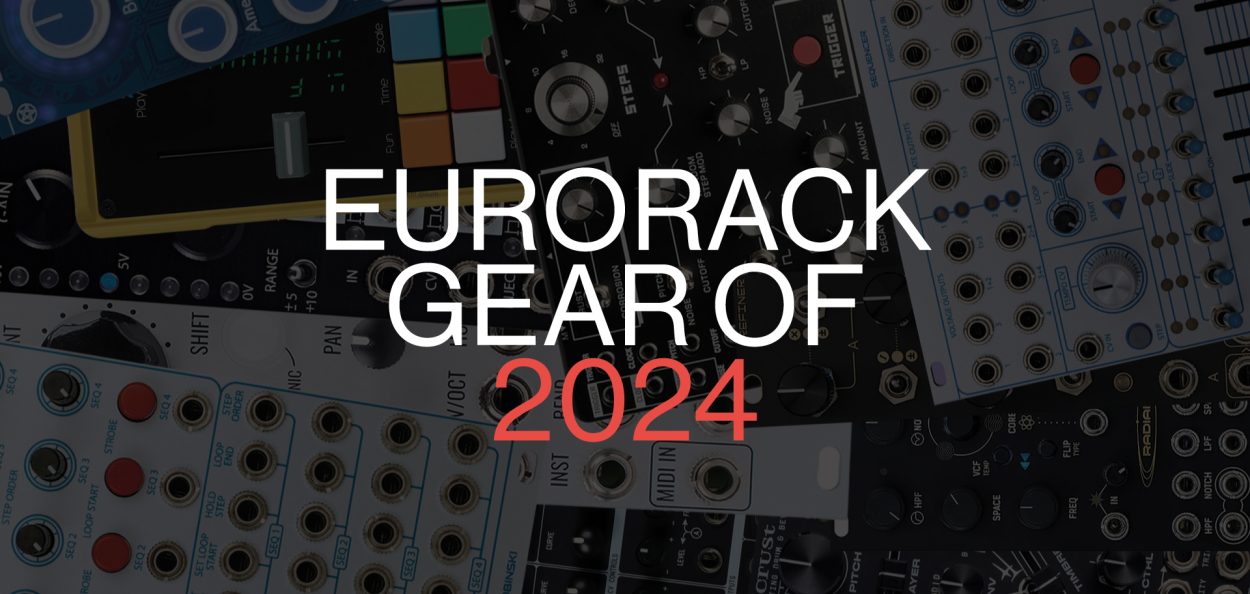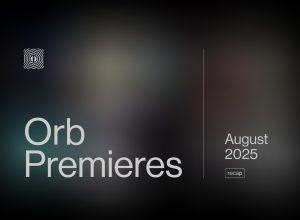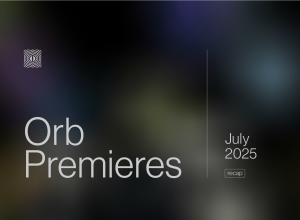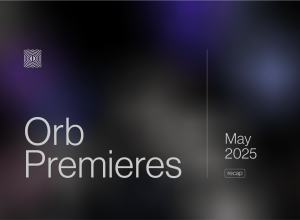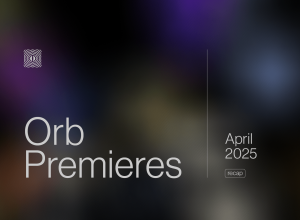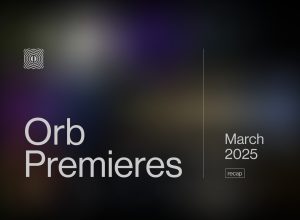The Eurorack ecosystem emerges from another year of transformation and resilience. Economic headwinds, lingering component shortages and price hikes, and a contracting market saw several beloved manufacturers scaling back or closing entirely. But like any vital creative ecosystem, module creators have responded not with retreat, but with inventiveness.
To some degree, this year’s landscape reflects a new evolution of the modular scene. While plenty of new makers are still cutting their teeth on reproductions or variations of existing circuits, it feels generally like we’re seeing a more curated, intentional approach to tool and instrument design. Experienced manufacturers are no longer simply adding features, but seemingly more deeply considering each circuit, interface, and potential interaction.
While it’s by no means comprehensive—there were far too many cool modules released in 2024 to test them all, let alone include all of them here—this year’s selection showcases the diversity and innovation within the modular community. From wild percussion generators to new ways of generating sequences and modulation, there’s clearly no lack of ideas in the modular development scene. If you’re looking to expand your setup with new sonic possibilities, or fill the gap in your rack with that one last bit of functionality, there’s inspiration aplenty to be found below.
Bastl Instruments Crust Drum Voice
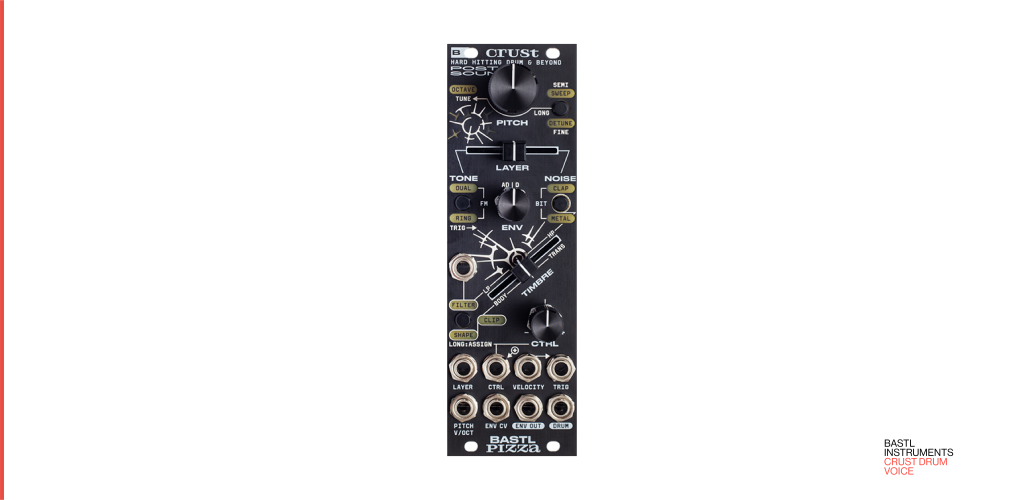
Bastl’s Crust is built on the same powerful digital platform as its popular Pizza oscillator, and brings an entirely fresh dimension to drum and noise generation. Its core design centers on a dual-layer architecture that provides significant sound design flexibility. The tone section features a dual oscillator setup with multiple configurations, including frequency modulation (FM) and ring modulation, which allows for complex signal routing and sound generation beyond simple oscillator functions.
The noise source is equally versatile, offering four distinct modes—white noise, clap, bit, and metallic—each with unique characteristics. The white noise provides a standard noise foundation, while the clap mode generates percussive-style noise, the bit mode introduces digital-style noise artifacts, and the metallic mode creates more resonant, bell-like noise textures. These modes can be further shaped through the module’s extensive modulation capabilities.
What makes Crust special is its ability to blend and modulate these noise and tone layers in multiple ways, simultaneously. The layer fader enables smooth crossfading between the two, while additional manual and CV control over layer, as well as envelope, velocity, pitch, and pretty much everything else on the module (via an assignable input) lets you get intricately modulate these two sound generation sections to achieve extremely feral, digitally distorted percussion.
A number of thoughtful details enhance the module’s versatility. The tone generator includes a pitch envelope with nuanced detune capabilities, further extending the module’s sonic reach, and allowing for intricate pitch sweeps and fine-tuned oscillations. The timbre section incorporates two distinct clipping modes: a transient shaper with hard clipping for aggressive, punchy sounds, and a soft clipper with bass boost for more rounded, full-bodied tones. This provides users with multiple approaches to sound shaping and dynamics control.
While it’s a great addition to any case, Crust really thrives in a small, focused rig, with an impressive amount of hands-on control. Squeezed into just 8HP—with the right modulation and the appropriate musical context—it’s quite capable of handling all or at least the bulk of one’s drum/percussive needs, all on its own. As with other recent Bastl releases, it’s incredibly deep: an array of button combinations let you get a wide range of tones and timbres out of it, which can steadily evolve over the course of a live set.
A simple but ingenious feature is the module’s innovative sample-and-hold functionality. By holding two buttons and inserting a cable into a desired jack, users can transform any input into a sample-and-hold voltage source—a clever design that adds a lot to the modulation possibilities on a drum module, without the need for an external sample-and-hold. While users will want to consult the manual (and definitely watch the video tutorial by Bastl’s Václav Peloušek, who makes some of the best video manuals in the game), the module’s thoughtful and consistent UI approach means users will quickly wrap their heads around Crust’s capabilities. Another banger from Brno.
Infinite Digits x Toadstool Tech Ectocore
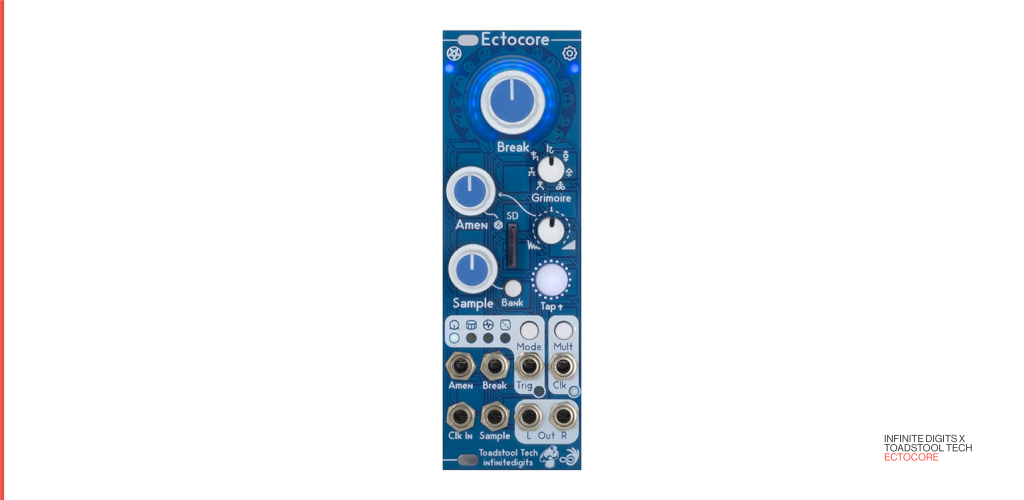
In the long arc of music technology, Ectocore represents something of a moment in time. As we crest the year of our lord 2025, we now have a Eurorack module with a dedicated Amen knob. In an increasingly challenging and unpredictable world, such revelations are indeed possible. Amen.
A co-creation from Infinite Digits and Toadstool Tech, Ectocore is essentially a purpose-built algorithmic breakbeat chopper, rungler, sequencer and mangler. It’s a compelling proposition: slice a bunch of samples via its dedicated web sample editing tool, drop them onto a microSD card, and bring frenetic, clock-synced and CV-sequenced breaks into your modular rack, with hands-on and CV control. (It’s worth noting that Infinite Digits’ own Zeptocore puts much of this functionality in the form of a Pocket Operator-style handheld.)
Things start with the sample editing web tool, which lets you dial in things like the number of slices, source BPM, and the like (you’ll get best results with even splicing, making sure that the source BPM matches the total length of the sample). Once your samples are loaded up onto the included microSD card. you’ll want to feed the Ectocore an external clock, or use the tap tempo button input to generate its own (conveniently, the module’s clock output functions as a multiplier/divider for incoming clock signals as well). Next, select your sample and effects banks, dial in your volume and drive levels, and you’re off to the races.
The Amen knob is arguably where the most action lives, scanning between the selected sample’s chops. Inspired by Turing Machine and Rungler-style sequencers, Ectocore creates looping slice patterns, enabling anything from slice variations to chaotic repeating stutters, or both. Feeding the Amen CV input various forms of control voltage (particularly stepped and sample-and-hold voltages) is lots of fun.
These samples then run through a complex network of effects, adding even more chaos and unpredictability to the proceedings. Ectocore operates with eight different user-defined FX banks, each accessible via the Grimoire knob (you set up which effects are in which bank via the web tool). These effects range from glitchy distortions and tape delays to intricate textural manipulations, making it a powerhouse for wild, unpredictable sonic assaults. The density of these effects is controlled via the Break knob, which determines how frequently the effects are applied to the sample slices. At its extreme settings, you can expect complete and utter mayhem.
This being Eurorack, pretty much all of the aforementioned actions can be CV controlled. With CV control over the sample selection and slices, and audio that streams directly off of the microSD card, you’re effectively able to cut between as many samples and slices of said samples as your brain can (or can’t) keep track of. Hands-on control over the built-in multi-mode filter and gated chopper bring even more interactive density to this little 8HP beast. You even get a trig output with various modes, which fires trigs off when designated slices play—letting you, for instance, layer in another drum or bass sound on top of Ectocore’s sliced kick or snare hits.
While Ectocore definitely shines when you feed it breakbeats, it’s also surprisingly good for samples of other types as well—melodic, textural, and vocal samples are all great fun to chuck into the blender and see what comes out. The module isn’t designed for hyper-controlled precision edits, but rather for creating choppy, glitchy chaotic sample madness, and it’s very, very good at doing just that. Hold on tight.
Analog Sweden SWEnigiser Proto VCF/A
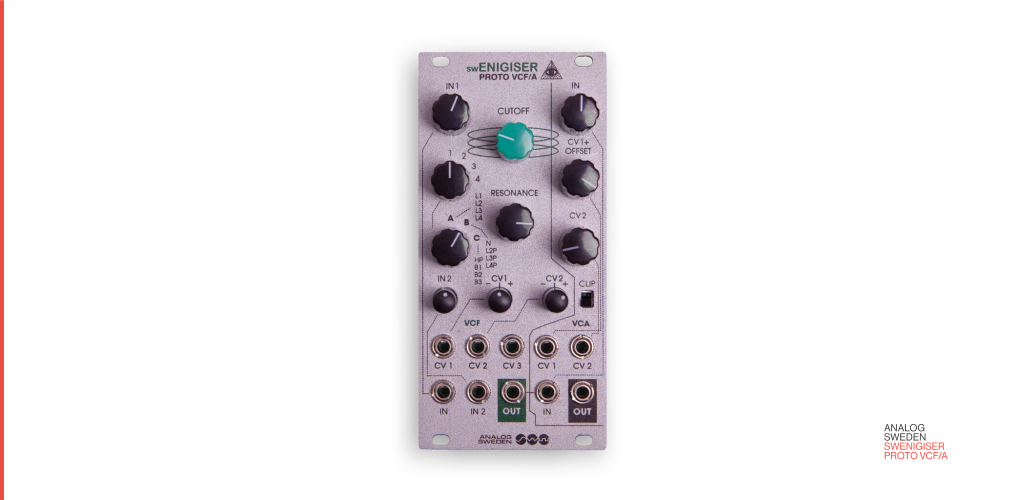
Analog Sweden’s SWEnigiser Proto VCF/A represents a fascinating resurrection of synthesizer heritage, breathing new life into a prototype filter design from the obscure Orgon Systems. More than just a simple recreation, this Eurorack module is a meticulous reinterpretation that honors its predecessor’s sonic DNA, while introducing contemporary functionality that speaks to the needs of modern electronic musicians.
At its heart, the module’s multimode filter—a complex 3×4 configuration—offers a fascinating level of tonal manipulation that transcends traditional filter design. This is a sound sculpting tool, capable of everything from whisper-soft atmospheric textures to brutally aggressive, resonant sweeps that can rip through a mix. Its filter modes can transform from smooth, round low-pass characteristics to sharp, cutting band-pass configurations with remarkable fluidity. It has two audio inputs, two filter cutoff inputs with attenunverters, and another filter input that tracks 1V/Oct.
Sonically, the Proto VCF/A exists in a rather fascinating liminal space between vintage warmth and cutting-edge digital precision. Its filter stages can simultaneously evoke the rich, organic character of classic analog synthesizers while maintaining a clarity and definition that speaks to modern production techniques. The integrated VCA, with its gritty drive circuit, adds another layer of sonic complexity, allowing the user to introduce controlled distortion and harmonic saturation, from subtle tube-like warmth or to more extreme territories of signal destruction. (The VCA can also be held open with the CV1 knob, and a Clip switch changes diode clipping modes between new and old versions of the circuit design.) The gorgeous, textured stainless steel front panel also deserves mention, complementing the impressive overall aesthetic design of the module.
Analog Sweden has created something quite unique here: a module that doesn’t just reproduce a classic sound, but reimagines what that sound could mean in contemporary musical contexts. For modular synthesists seeking to expand their sonic vocabulary, the Proto VCF/A represents something of a bridge between synthesizer generations, honoring historical sound design while pushing firmly into unexplored musical territories.
Half-Time Modular Refiner
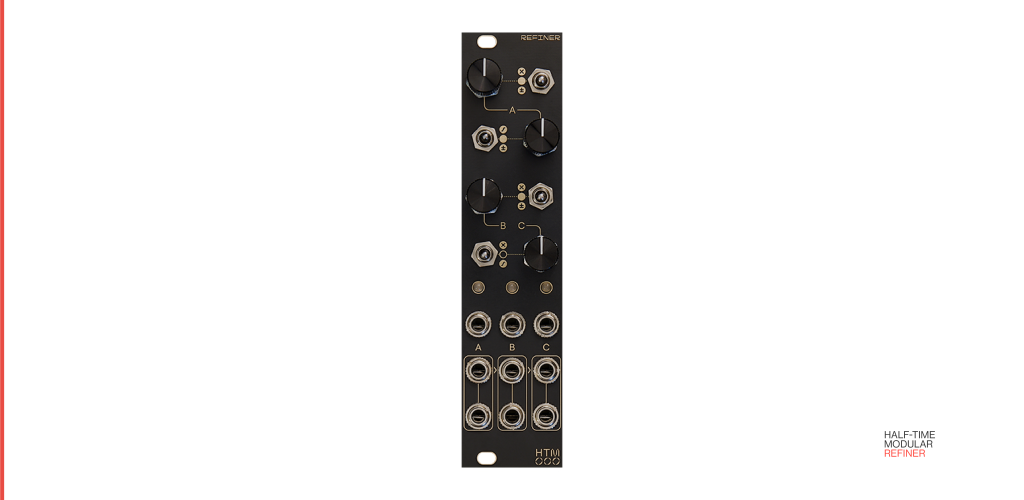
One among the new manufacturers, Half-Time Modular’s trio of initial releases, Refiner is a compact, versatile CV processing module that earns its place as an essential utility in any Eurorack setup. Packing a wealth of features into a slim 6HP, it’s capable of precise attenuation, offsetting, and slew limiting. Whether scaling signals, dynamically transposing sequences, or creating performance-ready effects, the Refiner is an adaptable toolkit for modular synthesizers. Its three independent channels offer creative flexibility, making it a powerful tool for signal shaping and performance.
Each of these three channels brings unique functionality to CV processing. Channel A features two stages in series for attenuation, offset, or bypass, with a second stage that adds slew limiting. This makes it ideal for precision scaling, or for adding subtle glide to volt-per-octave signals. Channel B is a simpler version of A, with attenuation and offset, while channel C stands out with its +5V reference input, enabling it to act as a voltage generator, or to produce smooth rises and falls via slew limiting. Its slew rate limiter is particularly noteworthy, with a range from fast transitions (100V/s) to slow, gradual glides (0.45V/s), making it a perfect fit for dynamic performance transitions or natural-sounding pitch slides. Each channel has two outputs: when the first output is left unplugged, the signal is mixed with the output of the next channel, while the second output is always a copy of the first channel.
The Refiner feels like it was very much designed with users in mind. The LEDs display output polarity and intensity, simplifying adjustments—helpful for both live and studio use. Additionally, the jacks’ normalization enables mixing and buffered multing, which is great for basic patching workflows, and when working with just one or two input voltages. Finally, its particularly stable voltage references make it great at handling pitch transpositions, even with unstable power supplies or temperature variations. An excellent addition to any modular toolkit.
Play All Day PlayFader
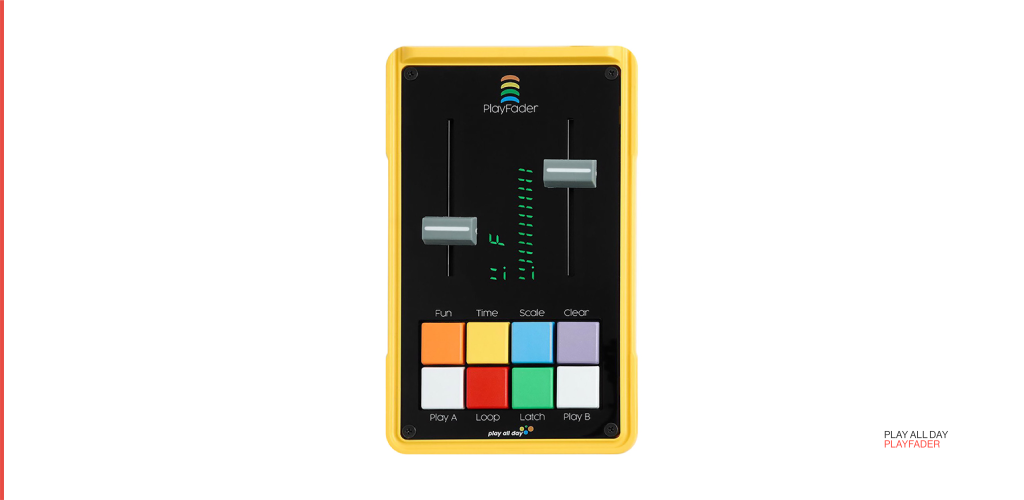
A collaboration between Play All Day and Jason Hotchkiss of Sixty Four Pixels (creator of the excellent CV.OCD), the PlayFader is a quirky, portable standalone two-channel CV and MIDI sequencer. It’s packed with features like dual loop buffers per channel, a dedicated FUN button (equipped with seven FUN FX), a unique latch play feature, and quantization with live transpose. It’s designed as a tool for spontaneous jam sessions, with hands-on, unconventional sequencing.
Beneath its playful exterior is a very capable tool, with dual MIDI/CV/gate outputs, and comprehensive control across analog and digital domains. Essentially, you play it by moving the fader through scales of notes, and entering those notes into a sequence with button presses in realtime. What could be a simple controller is actually quite a deep compositional tool, with features like 64-step sequencing per channel, patch memory and live transpose. Unlike more rigid, step-based sequencers, it prioritizes live manipulation and unexpected musical moments. And because the faders can be set to smooth input, the two channels are perfectly suited to CV modulation duties as well.
The aforementioned FUN button is exactly that, allowing you to instantly apply a variety of effects to your sequences. The effects include re-triggering, pitch shifting, randomization, and more, giving you the power to transform your sound on the fly. Users can trigger the pitch shift effect to create sudden octave jumps or microtonal variations, while the randomization function can introduce controlled chaos by generating unexpected note sequences or rhythmic variations. Each effect can be applied with varying intensity, and generally feels a bit like using punch-in effects (but not quite).
The PlayFader isn’t designed as lab-grade equipment; it has a decidedly homemade feel, with a chunky, injection-molded recycled plastic housing and lofi alphanumeric screen. But with its included top cover and 9V myVolts Ripcord for powering via USB, it’s definitely portable and durable enough to chuck in a bag, and the top and bottom panels have a lifetime warranty should they get damaged (a relatively easy fix, thanks to its modular design). The device and cover hold together with an included rainbow wristband. It’s a whole aesthetic, really.
The PlayFader isn’t about achieving perfect sequences, but about inspiring musical ideas. It invites the user to approach note generation with spontaneity, breaking down the traditional barriers between intention and accident. For electronic musicians tired of keyboards and step sequencers, it offers a refreshing alternative that celebrates the unpredictable nature of music creation.
Body Synths Metal Fetishist
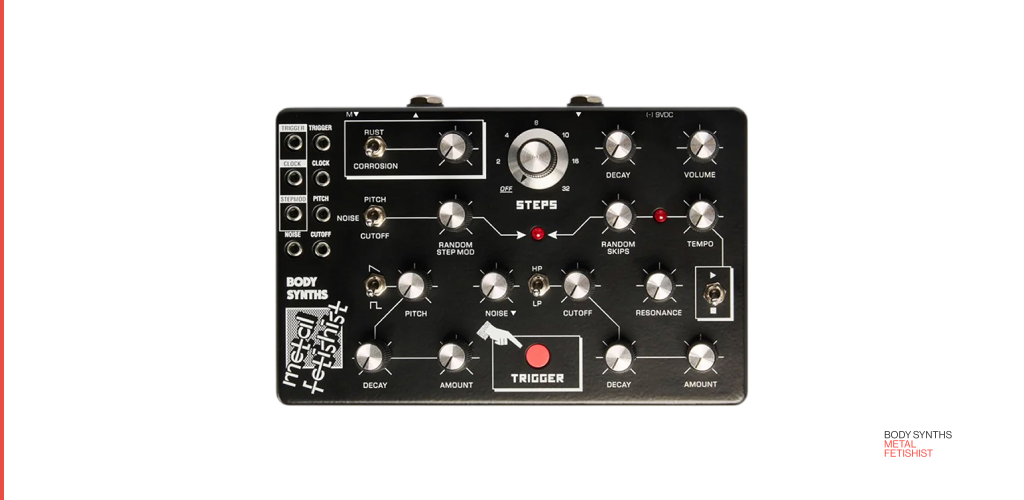
Beyond its tank-like construction and alluring front panel, the Metal Fetishist by Body Synths is a machine for discovering and manipulating rhythms. It’s a looping digital percussion synthesizer featuring a single oscillator capable of saw and square waveforms, paired with a white noise source. These foundational elements route through a resonant multimode filter (low-pass and high-pass), and then a digital distortion section with downsampling and overdrive capabilities. Drawing inspiration from instruments like the Moog DFAM, it employs three distinct envelopes controlling pitch, filter cutoff, and volume, but generates a range of very different sounds that can venture into fantastically raw, acidic sonic territories.
The module’s idiosyncratic approach to sequencing abandons traditional step programming in favor of intuitive, randomization-driven sound generation. Central to this philosophy are the Random Step Mod—which controls the degree of randomness applied to pitch, noise, and/or filter cutoff—and Random Skips knob, which effectively dictates where the trigs are placed on the grid. These interact with a Turing Machine-style lockable looping sequencer, allowing you to reset sequences and lock random values into sequences ranging from 2 to 32 steps. It’s a simple, intuitive, and super fun workflow that feels freeing and uniquely its own.
While percussion is its native tongue, Metal Fetishist’s abilities extend beyond conventional drum synthesis. The 1V/Oct pitch input means you can pair it with a quantizer and get some wild basslines. The audio input enables external signal processing, adding layers of grit and texture to whatever runs through it (this input replaces the onboard noise generator). Likewise, the ability to run the clock well into audio rate also means it can function as a grizzly, gnarled drone synth. When synced to an external clock (analog or MIDI), the tempo knob doubles as a clock divider and multiplier. CV inputs for pitch, noise, cutoff, clock, and trigger—alongside CV outputs for its random step modulation, clock, and trigger—provide extensive external and self-patching possibilities.
Expect a sonic palette spanning everything from booming bass hits and metallic strikes to expansive digital noise landscapes. Metal Fetishist’s sound generation is thick, digital, and raw, with distortion that can be dialed in to create anything from slight grit to full-on downsampled crunch. Ultimately, the module’s monophonic architecture becomes a creative strength, letting the user focus their energies on generating complex, massive and mutating percussion voices rather than step-by-step sequencing. It encourages improvisational sonic exploration over rigid programming, and it’s easy to get lost for hours exploring almost entirely with your right brain.
While it is certainly adept at producing recognizable percussion (particularly kicks and hi-hats), the Metal Fetishist wants to venture to experimental territories. Each generated pattern and knob turn emerges with interesting timbral and textural changes, which develop organically through interconnected modulation parameters and user input. It represents a radical instrument from a singular vision, and opens up exciting new territory for those fascinated by the rhythmic arts.
Dnipro Modular Radiant
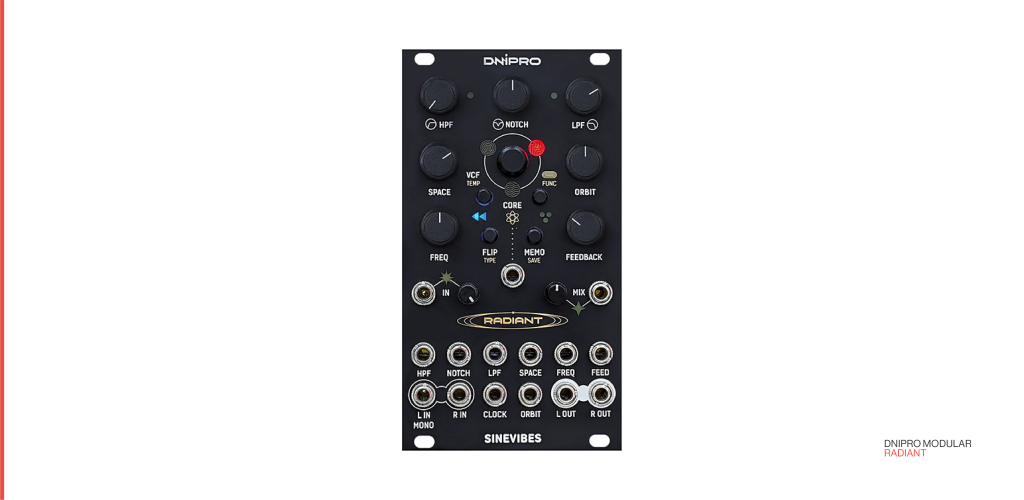
Another joint effort on this list, Radiant has emerged from a collaboration between two Ukrainian developers, Dnipro Modular and Sinevibes. The former is known for their innovative Eurorack designs like Krait and Metamorph, while the latter has carved out a niche with their range of excellent effects plugins for computers, as well as for outboard gear like the Korg NTS-1 and Minilogue XD. With Radiant, the result is an inspired, fantastic-sounding multi-effects module that’s full of ideas, and which covers a ton of audio processing ground in a single 14HP module.
The module offers six distinct effects: Dub Delay, Pole Phaser, Chord Wrapper, Feedback Shifter, Distortion, and Re-Trigger, each crafted to provide meaningful and unique sonic transformation. The Dub Delay introduces warm, spacious echoes with CV control over stereo width, while the Pole Phaser adds wonderfully swirling stereo movement and texture. The Chord Wrapper expands single notes into harmonic structures by adding two additional frequency-shifted intervals, and is capable of transforming single note inputs into three-note chords. The Feedback Shifter is perhaps the wildest of the bunch, creating otherworldly, pitch-shifted echoes, while the Distortion algorithm brings multiple flavors of distortion and bitcrushing. Finally, Re-Trigger adds rhythmic complexity by creating stuttering repetitions and chops to slices of the audio buffer. Radiant’s uses extremely high-fidelity, precise DSP; the effects sound fantastic across the board, and provide a huge amount of creative possibility.
In addition to these discrete effects, an onboard 3-band filter with high-pass, low-pass, and notch modes provide a huge amount of sound-shaping flexibility. (The filter can be applied to only the wet signal, or both the wet and dry signals.) It’s an addition that feels like it adds exponentially to the possibilities of the main effects, well more than the sum of its parts. Even the most minor of filter adjustments can make a massive difference to the sound, providing precise tonal control—from gentle frequency sculpting to more pronounced sonic alterations. Radiant also has a fantastic-sounding built-in reverb (for which a single knob controls the amount and size), providing a modular rig with pretty much all the effects it might need. A dedicated sound reverse function reverses the audio signal, and can be synced to the external clock. Stereo input and output and clock sync, along with extensive manual controls and CV inputs for each mode, further expand the module’s versatility.
That’s quite a lot of functionality, but where the module further distinguishes itself is with its preset morphing. Essentially, you can save three different effect configurations and transition between them, either manually or via CV control. These can be gradual transitions, rapid cuts or anything in between, depending on your choice of CV input. This morphing is extremely responsive, and allows for dynamic sound design that can evolve organically, creating subtle shifts or dramatic transformations in wild and unpredictable ways. Happy accident seekers, this one’s for you.
What makes Radiant so compelling isn’t just its impressive technical specifications, but how it translates this technical prowess into musical potential. It’s a module that feels equally at home in ambient soundscapes, experimental compositions, and more rhythmic contexts. Its balance between predictability and surprise—all wrapped in some top-tier, lovely sounding DSP—makes it an amazing tool for sound designers, composers and performers alike.
Schlappi Engineering BTFLD
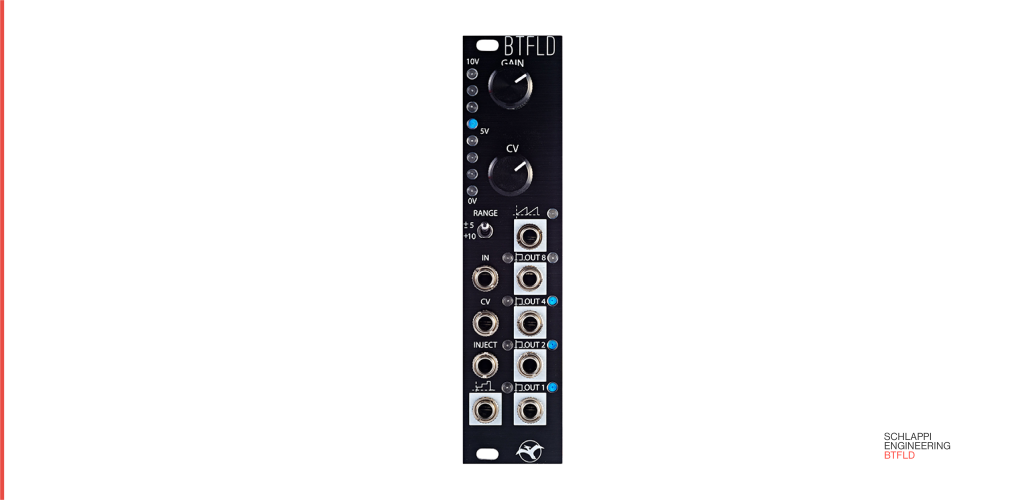
Schlappi Engineering’s BTFLD (“bit fold”) somewhat defies traditional categories, offering a Swiss Army knife of CV and audio manipulation. At its core, the module transforms incoming signals through a four-bit asynchronous analog-to-digital converter, generating multiple unique outputs that can function simultaneously as audio processors and modulation sources. More than just a wavefolder or distortion unit, BTFLD combines analog-to-digital conversion with creative binary manipulation to explore new sonic territory.
Regardless of what you run into it, the module comes alive through its diverse output options. For audio processing, the saw output stands out as particularly interesting, producing complex timbres that evoke hard-sync-like effects when paired with oscillators. By introducing subtle phase modulations, you can coax rich, harmonically intricate sounds that seem to exist between traditional synthesis techniques. The stepped output crushes signals into 16-step binary values, delivering a gritty digital texture perfect for experimental sound design. Meanwhile, the various square outputs (OUT1, OUT2, OUT4, and OUT8) deconstruct signals into their binary components, allowing for everything from precise clock divisions to complex rhythmic gate patterns.
Versatility is at the heart of BTFLD’s design philosophy. A range switch enables seamless transitions between audio and control voltage processing, while gain and attenuation controls allow for fine-tuned signal shaping. Patching becomes a highly exploratory process: a sine wave input might yield harmonically rich textures through the saw output, while blending stepped and square outputs can reintroduce dynamic complexity to seemingly crushed signals. A complex or even simple LFO input can generate intricate polyrhythmic patterns, while audio-rate signals unlock more chaotic, aggressive sound sculpting possibilities. The Inject input becomes a playground for subtle phase modulations and aggressive signal transformations.
Schlappi has long been known for creative, technically sophisticated designs, and BTFLD certainly reinforces this reputation. The module blurs boundaries between distortion, wavefolding, gate sequencing and digital processing, offering a fresh perspective that challenges traditional synthesis paradigms. If you don’t have an advanced degree in binary logic—and, frankly, likely even more so if you do—BTFLD is one of those modules that’s constantly revealing surprises and creative possibilities. Running pretty much any and all signals from your system into it, injecting CV, and simply seeing what comes out is where modular synthesis is at its experimental best.
Tobinski Sequencer + Sequencer Expander Modules
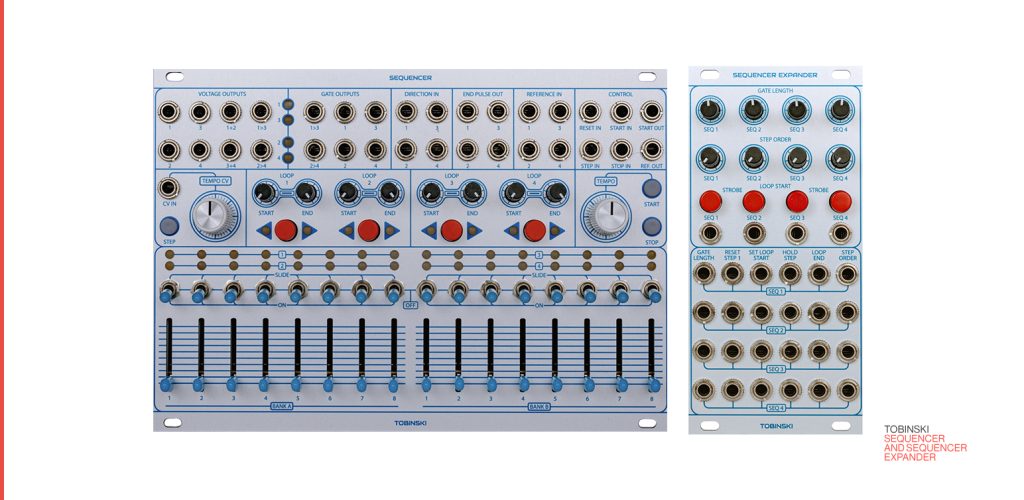
In the ever-expanding world of Eurorack sequencers, the latest duo of sequencing modules from Tobinski (f.k.a. Dannysound) offers a deep, sophisticated approach to pattern generation and modulation. Using two interconnected sequencers that combine with one another in various ways, it excels at semi-generative and polyrhythmic sequencing of multiple voices. With their clean layout and subtle Buchla (via Berlin) aesthetics, the Sequencer and its Expander represent a beautiful, carefully designed system that provides remarkable flexibility and creative potential.
The Sequencer itself is a 36HP beast, featuring two banks of eight voltage sliders (including per-step on-off-slide switches) combined with two independent eight-step sequencers. Each sequencer offers independent start and end loop points, external clock inputs, and direction switches; combined with eight voltage and six gate outputs, it provides a deep and comprehensive toolkit for rhythmic and melodic exploration. These two banks can be combined in interesting ways, in the form of CV/gate outputs for sequences 1/ 3 and 2/4, that switch at the loop end pulse, for up to 16 step patterns. There are also additive voltage outputs for sequence 1 added to 2, and sequence 3 added to 4. (It’s worth noting that there’s no onboard quantizer, so if you’re looking to do melodic sequencing, you’ll likely want to pair this with a multichannel quantizer.)
The module gains even more dynamic potential from its modulation capabilities: CV inputs for tempo (with attenuation), direction, and playback transform sequencing from a predetermined process into an ever-shifting, real-time composition. If modulation sequencing is what you’re after, the sequencers can even function as multiple complex, dynamic envelope generators or LFOs.
The clocking and tempo possibilities with the Tobinski Sequencer are vast. By connecting voltage into the tempo CV input, you can use the tempo knob to create swing timings for the sequencers, and you get the flexibility to run longer patterns with more experimental timing variations. Additionally, you can do things like mult a sequence into the tempo CV input and an oscillator’s V/Oct input, using the tempo CV knob to adjust the speed at which higher or lower notes play, adding dynamic variation to your sequences. It’s a powerful tool for both traditional and experimental music composition.
The Expander module significantly extends the Sequencer’s capabilities through extensive modulation options. Connected via a ribbon cable, it introduces seven CV inputs for each of the four sequencer tracks, creating a host of modulation possibilities that goes far beyond traditional sequencing approaches. CV control over parameters like loop points, gate length, and step order enables you to create dynamic, evolving sequences that can dramatically transform over time. Manual controls for gate length, step order, and a ratcheting strobe mode invite hands-on manipulation, again nudging the sequencing process from a predetermined process into a live performance technique. You can reset patterns, hold notes, reorder steps, and introduce intricate rhythmic variations with immediate controls. Connecting an oscillator to the Loop Start CV input in Strobe mode even allows the sequencer to be used as a programmable waveshape oscillator. Wild stuff.
What sets Tobinski’s sequencing system apart is its balance between complexity and playability. While the depth of modulation and CV control could easily overwhelm less thoughtful designs, Tobinski has crafted an interface that feels intuitive and inviting. From multiple straightforward melodic sequences to intricate, self-generative patch ecosystems that evolve unpredictably with each pass, it remains approachable and engaging, encouraging exploration and creativity at every step.
ADDAC System Random Bézier Waves

Building on its track record of unique modulation sources like the Marble Physics and Swell Physics, ADDAC has partnered with Amsterdam-based artist and Eurorack educator Rijnder Kamerbeek (aka Monotrail) to create Random Bezier Waves. This unique collaboration combines ADDAC’s precision engineering with Kamerbeek’s compelling design ideas, developed through years as an educator and artist. The 8HP Eurorack module reimagines random voltage generation by implementing Bézier curves, creating smooth, organic transitions between values—a significant departure from traditional step-based slewed random sources. It’s a fantastic tool for adding subtle or dramatic instability and variation to patches.
At its core, the module features two independent channels of random bipolar CV generation. Each channel provides four essential controls: a Frequency knob determining the rate of random voltage generation (from very slow to audio rates), a Level control functioning as a VCA for the output amplitude, an Offset control for voltage range adjustment, and a dedicated Curve control that shapes the Bézier transitions between random values. This Curve control essentially manages the Bézier-based voltage interpolation—something typically found in graphics applications, and offers a unique alternative to traditional linear or exponential curves found in most Eurorack modules. Standard and inverted outputs are available for each channel, as well as individual gate outputs, and average and inverted averages of the two channels.
A nice feature is the three-position mini toggle switch located beside each Level control. This threshold mechanism influences how signals behave at crossing points, adding another dimension of voltage control behavior. Each channel includes bipolar CV inputs, with dedicated attenuverters for both Frequency and Level parameters. These inputs are normalled to the opposite channel’s output for inter-channel modulation possibilities (a feature that can be bypassed using jumpers on the module’s rear panel). Both channels incorporate color-coded LEDs, providing clear indication of modulation polarity and intensity.
As noted, Random Bezier Waves excels at generating evolving modulation sources. At slower frequencies and with gentle curve settings, it produces smooth, continuous voltage changes that are ideal for things like filter cutoff modulation or subtle detuning of oscillators. Higher frequency settings with steeper curves create more dynamic and dramatic modulation, suitable for more rhythmic applications or rapid parameter changes. The module’s ability to intertwine modulations between channels unlocks new realms of complexity, where each modulation influences another, creating a rich tapestry of change and pattern variation.
Random voltages are often used as a source of unpredictability to inject patches with a sense of organic movement. Here, the user gains impressively deep and precise control over this randomness, introducing meticulously-applied destabilization patterns throughout their patches. Features like the built-in offset controls—which make it an effective tool on all sorts of bipolar and unipolar destinations—demonstrate that this was built with the user in mind.
Sebsongs Modular Bread & Butter
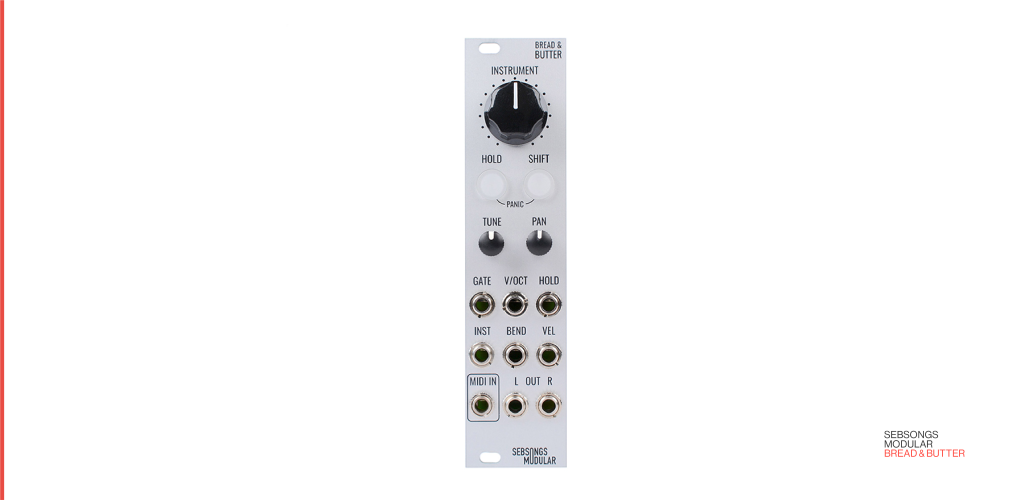
Sebsongs Modular’s aptly named Bread & Butter is a quirky addition to the world of Eurorack. Introduced at Superbooth 24, it’s a stereo, polyphonic synth voice, available as a DIY kit from Thonk. It offers a General MIDI-based sound palette with 128 selectable instruments (more on those in a bit), making it a flexible and fun addition to any modular setup. While it’s not what the Eurorack format generally tends towards, it can function as a surprisingly handy addition to those looking for a flexible and immediate polyphonic synth voice (and plenty more) inside the rack.
About that polyphony: With up to 64 voices, the module allows for rich, layered sounds that can decay independently, enabling users to create complex, evolving chords, including ratcheting chords that decay polyphonically. The voices can also sustain when the HOLD function is engaged. The module includes standard V/Oct and GATE inputs for triggering the synth voice, as well as a dedicated MIDI input for additional note triggering and control. This means that you can trigger different instruments and sequences simultaneously (via CV/GATE and MIDI, respectively), making it great for squeezing a lot of sounds out of just 6HP. You can, for instance, play chords via the CV/GATE inputs, and trigger drums via MIDI.
The presets themselves sound great, with a variety of instruments that range from classic synth sounds to more experimental soundscapes and effects. Looking to add MIDI versions of taikos, church organs, ocarinas or choirs to your modular rig? How about a harmonica, overdriven guitar, tenor sax or gunshots? Look no further than Bread & Butter.
While not necessarily the modulatable playground that typically defines and animates full voices in the Eurorack format, there’s voltage control over pitch bend, velocity, and instrument selection (the latter, however, is only addressable via MIDI). The pan knob allows you to spread the polyphonic voices across the stereo field, adding depth and spatial interest to the sound.
Bread & Butter occupies an unconventional space in the modular synthesizer world. It’s simultaneously a nostalgic nod to General MIDI’s idiosyncratic sound palette, as well as a forward-thinking addition to the Eurorack range. Whether used as a playful sound source, a complex layering tool, or an unexpected performance instrument, it can be a powerful and expansive addition to your rack.
